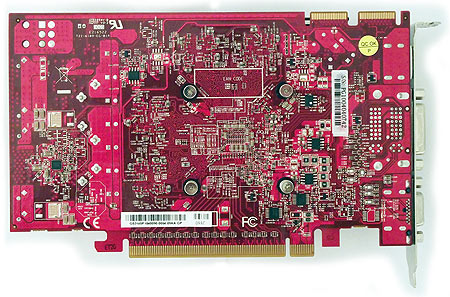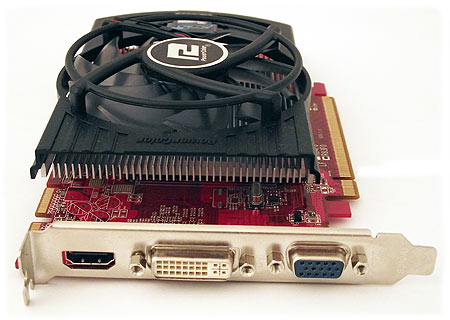Radeon HD 5550 And 5570: Pumped Up With GDDR5
AMD quietly introduced its new Radeon HD 5550 and prepped the Radeon HD 5570 GDDR5 to follow. We examine the performance of these two stealth-launched models to see if they have what it takes to replace a couple of power contenders in the sub-$100 market.
PowerColor PCS+ HD 5550 GDDR5
PowerColor’s PCS designation stands for Professional Cooling System, and in the case of the PCS+ HD5550 GDDR5, that cooling system is put to good use. The GPU is cooled enough to allow for a factory overclock of 650 MHz (100 MHz over the reference Radeon HD 5550 core clock specification). The card’s GDDR5 memory is clocked at the reference 900 MHz speed.
AMD tells us that the reference Radeon HD 5550 GDDR5 board does not have CrossFire fingers, but instead implements CrossFire functionality through the motherboard’s PCIe bus. PowerColor’s PCS+ model does have the CrossFire fingers present however, and closer inspection shows that this is actually the same circuit board as PowerColor’s custom PCS+ HD5670 card. CrossFire is more effective when the cards communicate over this proprietary link, so this feature might be attractive for folks who plan to upgrade with a second card later. The robust Radeon HD 5670 PCB gives us hope that PowerColor’s PCS+ HD5550 has good overclocking potential.
This card comes with a Spartan bundle consisting of a driver CD and installation manual, which is not surprising for a product targeted at the budget segment.
The card’s cooler is identical to the one used on the PowerColor PCS+ HD5670, which is pushed to much higher core clock speeds than the PCS+ HD5550. This cooler doesn’t have any trouble keeping the lower-clocked Radeon HD 5550 GPU cool.
PowerColor’s PCS+ card has a DVI, HDMI, and VGA output, which makes DisplayPort-dependant triple-monitor Eyefinity setups impossible. This is probably not an issue with most people looking for a budget solution like the Radeon HD 5550, though.
Overclocking
The card’s BIOS limits for CCC Overdrive clock speeds are 850 MHz core and 1100 MHz memory. Unfortunately, voltage modification doesn’t work in MSI’s Afterburner utility, so we’re stuck with the stock voltage. The 850 MHz core speed limit is very optimistic without the ability to add some voltage, but we are able to push the card to an impressive 775 MHz core and 1025 MHz memory. This results in some very impressive performance as you will see in the overclocked benchmarks.
Get Tom's Hardware's best news and in-depth reviews, straight to your inbox.
Current page: PowerColor PCS+ HD 5550 GDDR5
Prev Page HIS Radeon HD 5550 DDR3 And GDDR5 Next Page HIS Radeon HD 5570 GDDR5Don Woligroski was a former senior hardware editor for Tom's Hardware. He has covered a wide range of PC hardware topics, including CPUs, GPUs, system building, and emerging technologies.
-
welshmousepk crysis 2 'on the horizon'?Reply
either you have not heard the terrible news, or you are a far more patient man than I. -
gkay09 No surprises IMO as it was the same with the HD 4650/ 4670...the 1GB DDR2 was slower than the 512MB DDR3...Reply -
You've mixed up the HIS5550 and HIS5570 end-on port pictures I think. You state the 5550 GDDR5 has no VGA and one is shown and vice-versa for the 5570 GDDR5. In fact it looks like quite few of the pictures are misplaced.Reply
-
edlight When you do the HQV tests, could you investigate drivers? They have a desktop color and a video (movies) section. With my 4670, it's not always clear which videos the video section works on. It varies between Win 7 and XP. Basically it works on movies in the overlay, and/or players with hardware acceleration turned on. In Win 7 it works on the flash videos, in XP it doesn't. In XP in video you can adjust Gamma, in Win 7 you can't. In XP the brightness etc. adjustment in video is independent from the desktop. In Win 7 desktop adjustments to brightness etc. affect the videos, even in the overlay. In XP the Dynamic Contrast button is there, but does nothing.Reply
After driver 10.4, in XP, video brightness and other adjustments just don't work. If you want to adjust the video you have to go back to 10.4.
Contrast this with nvidia. As far as I know, their drivers work properly, with Gamma adjustment for video, and video brightness etc. separated from desktop brightness etc.
But, in the last nvidia drivers I tried, there are problems with profiles. While you're in video, you can't save the settings as a profile. You have to go to desktop. Then you can save them. You used to be able to right-click on the tray icon and select your profiles. In the last nvidia driver I checked, you couldn't do that. At least you can do that in the ATI drivers. You can't sort the darn things, though.
So, to select a profile in nvidea you'd always have to open the control panel. In ATI, if you've come upon a dark video and you have several profiles to try on it, it's fast and easy by right-clicking in the tray.
I don't think the programmers actually use the control panels themselves. Such awful logic!
One last thing I'd like to know from the coming article is if the nvidia video section works on flash videos (with the 10.1 flash) in XP. It must in Win 7. -
dconnors welshmousepkcrysis 2 'on the horizon'? either you have not heard the terrible news, or you are a far more patient man than I.Reply
I would say anything under a year is "on the horizon" so a March 2011 street date lines up pretty well with that statement.
-Devin -
Onus I would like to have seen the HD4670 in the benchmarks; I think that is more likely competition than the HD4650, which was beaten pretty badly.Reply -
Belardo Yeah, the 4670 does belong on this benchmark article, but for the most part - the 5570 OC is on par with a standard 4670. Give or take.Reply
But what really belongs here is the 5450!
That would show how much MORE powerful the 5550/70 cards are... Yeah I know, about 4x... but still it should be there. Maybe the 5470 will come out ;)
Current pricing of the lower 5000 & 4000 series (Order of performance)
5450 = $40~70 ($55+ = 1GB useless versions)
4650 = $50~80
5550 = $65~90 (DDR2 or DDR3 ver)
5570 = $70~90 (DDR3)
4670 = $70~90
5670 = $85~105
5750 = $125~150 (Ouch - considering they cost less to make that 4670s)
First, when it comes to DX11 games, they are too much for the 5550 and below - but under DX10 - they do pretty good. So for your $70~75, you might as WELL buy the 4670 over the 5550s and 5570-DDR3. Now if the the 5550-DDR5 sells for the same price or less of a 4670, then it maybe worth it.
Considering the age of these cards, the 5670 should be $80~90... as it doesn't touch the $100 4850! But the 4850 & 57xx requires more power/bigger PSUs.
A non-eyeinfinity version of a 5750 for $100 would be a sweat card to get that would hammer the nail into the 4800 series.



